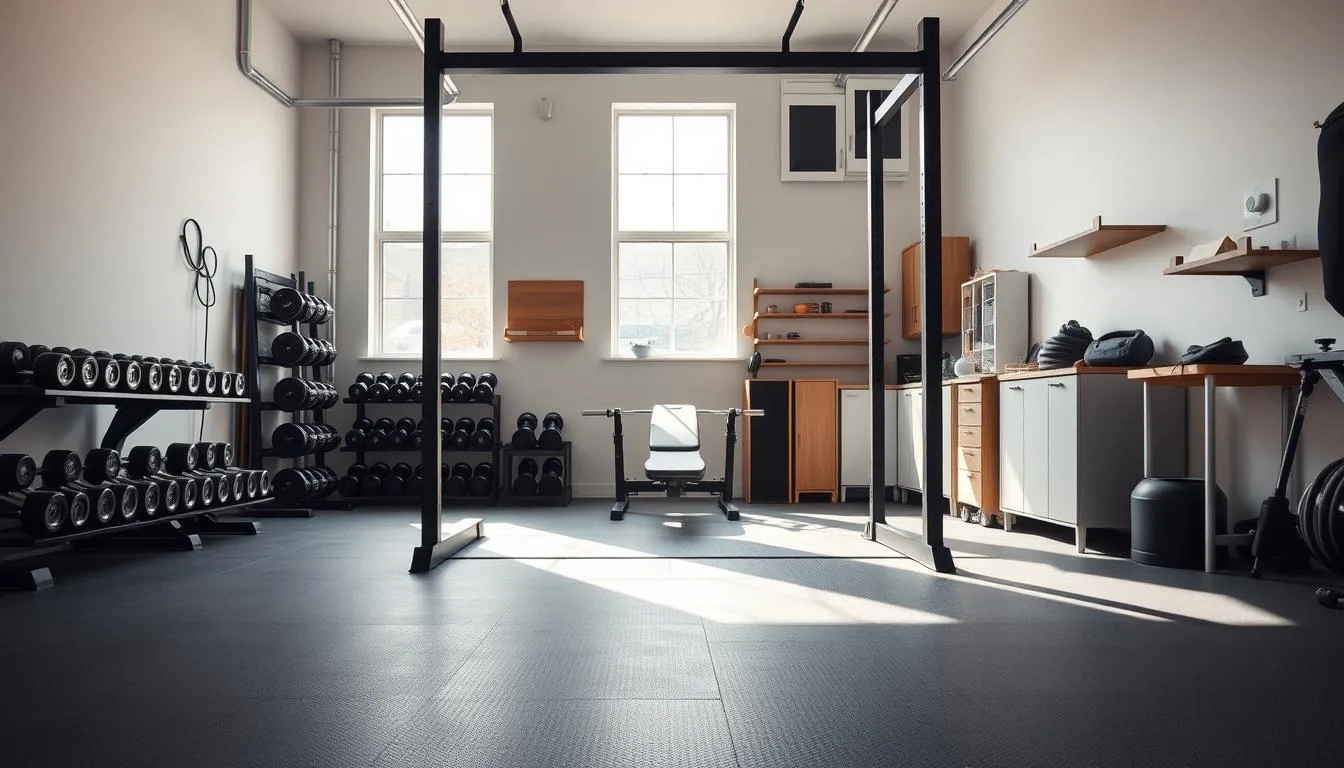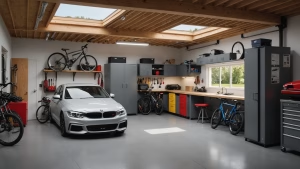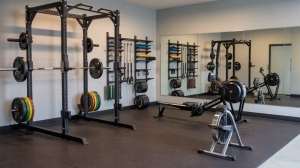With 75% of homeowners seeing their garage’s untapped value, turning it into a Garage Gym Design is becoming a top priority. Already, over 40% use their garages for workouts, highlighting the area’s fitness zone promise. This space now caters to both home exercises and side hustles, thanks to Custom Garage Gym setups and smart storage solutions.
The pandemic has forever changed fitness habits. Now, 78% of homeowners aim to declutter their garages in 2024, ready to maximize these areas. This guide will help you design a Garage Gym Design that meets your fitness needs. We’ll discuss layout planning, smart tech integration, and more, ensuring your space supports your fitness goals.
The Benefits of a Garage Gym
A Garage Gym Setup offers more than just space to lift weights. Over 41% of homeowners already use their garages for fitness, proving this trend’s growing popularity. With typical gym memberships costing up to $250 monthly, converting your garage into a DIY Home Gym saves money long-term. A one-time investment often recoups costs within a year, avoiding wasted fees for underused memberships. Statistic Brain Research Institute found 82% of gym members visit less than once weekly, highlighting how home setups boost consistency.
Convenience shines through time saved. Skipping a 10-minute commute plus changing time adds hours back into your week. Work out anytime, rain or shine, without waiting for equipment. The garage’s flexibility lets you focus solely on your routine, free from crowded locker rooms or late-night facility hours.
Customization tailors workouts to your goals. Fill your space with free weights, treadmills, or yoga mats—no one-size-fits-all equipment. Privacy matters too: exercising in your own space reduces pressure from others, making workouts more comfortable. Plus, 1789 user reviews show many enjoy inviting friends to train together, turning the garage into a social hub.
Health concerns like germ exposure at public gyms vanish at home. Hygiene control and safety are easier to manage. With 0% APR financing options available for purchases over $250, starting a Garage Gym Setup becomes accessible. Whether you prioritize saving money, time, or personal space, a DIY Home Gym adapts to your lifestyle while keeping fitness goals on track.
Key Design Considerations
Turning a garage into a gym requires careful planning. Over 76% of U.S. homeowners view garages as high-productivity spaces, a survey by Stanley Black & Decker reveals. Designing a small gym involves precise measurements to fit equipment like squat racks (17.5-18.67 sq. ft.) and treadmills (70-85” long). It’s essential to leave enough space for movement. Layouts must also avoid obstacles and consider ceiling heights, ideally 2 feet above your arms to prevent lift collisions.
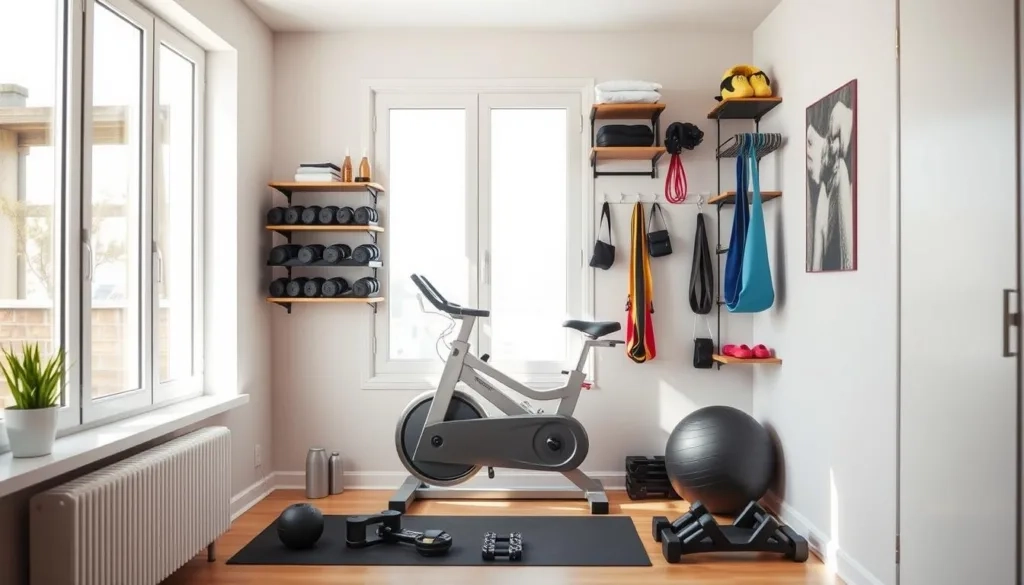
Climate control is critical. Insulating garage doors helps reduce heat loss, while LED panels or windows increase natural light. Lighting should be bright enough to eliminate shadows without glare. Recessed fixtures are safer than surface-mounted lights. Heating systems, like gas-powered units overhead, keep the area comfortable during workouts. Flooring, such as rubber or hardwood, protects against heavy equipment and ensures durability.
Structural support is essential. Steel beams secure heavy equipment, and walls need reinforcement for items like pull-up bars. Electrical outlets should be placed safely to avoid tripping hazards. Storage solutions, like wall racks, help keep the floor clear, which is vital in small spaces. Prioritizing equipment based on fitness goals ensures a practical layout without overcrowding.
Essential Equipment for Your Garage Gym
Creating a Garage Gym Equipment setup begins with key items that optimize space and budget. A barbell system is the cornerstone. The Rogue Fitness Ohio Bar, boasting 190K PSI tensile strength, is durable and priced under $400. Combine it with a Titan T-3 Series Power Rack, starting at $465, for its 2” x 3” steel and 1” hole spacing versatility. For those on a tight budget, the REP Fitness FB-5000 bench (under $240) supports up to 1,000 lbs, perfect for small areas.
Cardio doesn’t need to occupy a lot of space. A rowing machine, engaging 86% of muscles, can fit in a small garage. Options like the WaterRower Natural (under $1,000) are compact. Jump ropes and resistance bands, costing under $20, offer significant value. Adjustable dumbbells, such as the Snode AD80 (starting at $795), replace multiple pairs, saving space and money. Kettlebells, like the Iron Bull HD (from $63), provide full-body workouts at a low cost.
Focus on the basics first. A $1,300 starter kit, including a barbell, rack, bench, and plates, offers more value than a decade of gym memberships. Traditional memberships cost $6,960, while CrossFit memberships reach $15,000. Opt for multi-use gear like pull-up bars or hexagonal plates. Brands like REP Fitness and Rogue Fitness provide warranties, ensuring long-term use. Expand your setup with cardio or functional tools like battle ropes or medicine balls as space permits.
Creating a Motivating Atmosphere
Music is key in setting the mood for any workout. Rock music is the favorite in garage gyms, with 42% of homeowners choosing it, surveys show. Pop, country, and hip-hop are close seconds. A sound system paired with streaming services can match the intensity of your workout. Using over-ear headphones or wall-mounted speakers can also reduce echo, making the space more inviting for focused training.
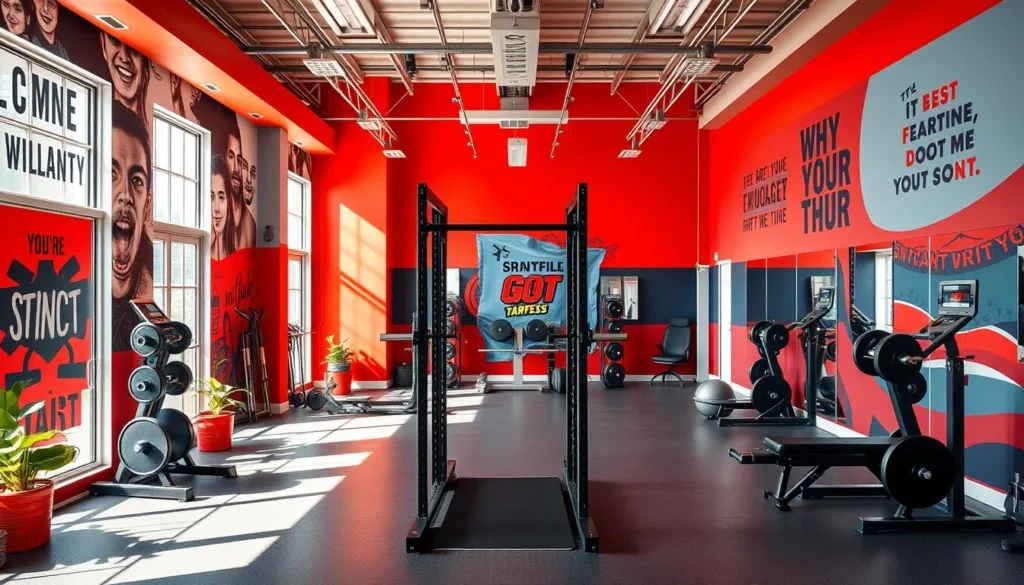
Visuals play a significant role. Dark natural wall tones like charcoal or espresso create a grounded feel. High-gloss paint on lower walls reflects light, making smaller spaces appear brighter. Strategically placed mirrors help track form and expand the perceived space. Wall decals or motivational quotes add personal touches without clutter, essential for small layouts. Felt Right acoustic tiles dampen noise while adding color, blending function with style.
Lighting and order boost motivation. Natural light from garage doors is ideal, but LED panels ensure visibility during winter. Keeping floors clear of equipment with overhead racks or wall-mounted storage is essential. The Broken Windows Theory applies here: a clean, organized space encourages routine adherence. Minimalist use vertical storage and foldable mats like Stakt to maximize openness.
Personalization fuels consistency. Displaying workout goals or progress charts at eye level can motivate. Brands like B Yoga offer magnetic wall kits for temporary art. Pairing compact gear like the WalkingPad C2 Mini with compact strength tools like adjustable dumbbells from The Weight Kit ensures efficiency. A motivating atmosphere isn’t just decorative—it’s a science. Thoughtful design turns the garage into a space users can’t wait to enter.
Flooring Options for Functionality and Safety
A sturdy floor is essential for a safe DIY Home Gym. With 76% of homeowners using their garage for productivity, the choice of flooring must balance durability and safety. Rubber flooring is the top choice due to its shock absorption and longevity. Flooring Inc’s 8MM Strong Rubber Rolls, priced from $2.25 to $3 per square foot, boast a 5-star durability rating and a 5-year warranty. These rolls, available in 24 colors, create a seamless surface perfect for heavy lifting.
Interlocking tiles like Living.Fit’s 10mm mats ($50 for 40×40 inches) offer flexibility and resist moisture. They are easy to install and protect joints and equipment, lasting over a decade with proper care.
For lighter workouts, foam or carpet might be suitable. Foam tiles, though affordable, compress under heavy weights. Carpet tiles, like Second Skin Stomp Mat’s 0.25-inch options, provide grip but need occasional professional cleaning.
For high-impact exercises, synthetic turf or commercial-grade PLAE Forge flooring (12mm thick) offers stability. They require labor-intensive installation. Vinyl tiles, such as Performance Turf Rolls at $2.79 per square foot, resist chemicals and mold, making them ideal for garage humidity. Tractor Supply’s Rubber Stall Mats (0.75 inches thick) combine weight resistance and drainage.
Subfloor preparation is key. Moisture barriers and leveling compounds prevent buckling on sloped floors. When dropping weights over 100 lbs, thicker rubber or turf underlayment safeguards subfloors. Prioritizing materials that match workout intensity ensures longevity. Whether upgrading a Garage Gym Design or starting fresh, matching flooring to needs turns the garage into a functional fitness hub.
Incorporating Storage Solutions
Efficient Garage Gym Organization begins with smart storage. With 50% of homeowners planning to invest in solutions like wall-mounted systems and storage bins, prioritizing space-saving strategies is key. Vertical storage maximizes floor space, allowing more room for workouts. Wall-mounted racks and pegboards keep barbells, plates, and accessories off the ground.
They offer customizable hooks and shelves for small gear like jump ropes or resistance bands.
Multi-functional storage doubles as workout tools. Benches with hidden compartments or rolling racks that move with you save space without sacrificing access. Power racks with built-in plate holders eliminate clutter, while 2- or 3-tier dumbbell racks organize weights by size.
Overhead solutions like motorized ceiling racks store infrequently used equipment, freeing up floor area for exercises.
Small Space Gym Design thrives with intentional planning. Use storage bins for accessories and wall hooks for mats or belts. A vertical plate tree keeps discs stacked neatly, reducing trip hazards.
Durable shelving holds heavy equipment while staying within reach. Custom cabinets from brands like The Garage Center offer tailored layouts, ensuring even large collections don’t overwhelm the space.
Regular decluttering (78% of users plan to do this in 2024) maintains functionality. Keep walkways clear and group items by use. Slatwall systems let users adjust storage as needs change.
Interlocking foam mats save floor space for cardio areas, while wall-mounted hooks for mats prevent floor clutter. Thoughtful Garage Gym Organization transforms chaos into a safe, efficient workout environment.
Ensuring Proper Ventilation
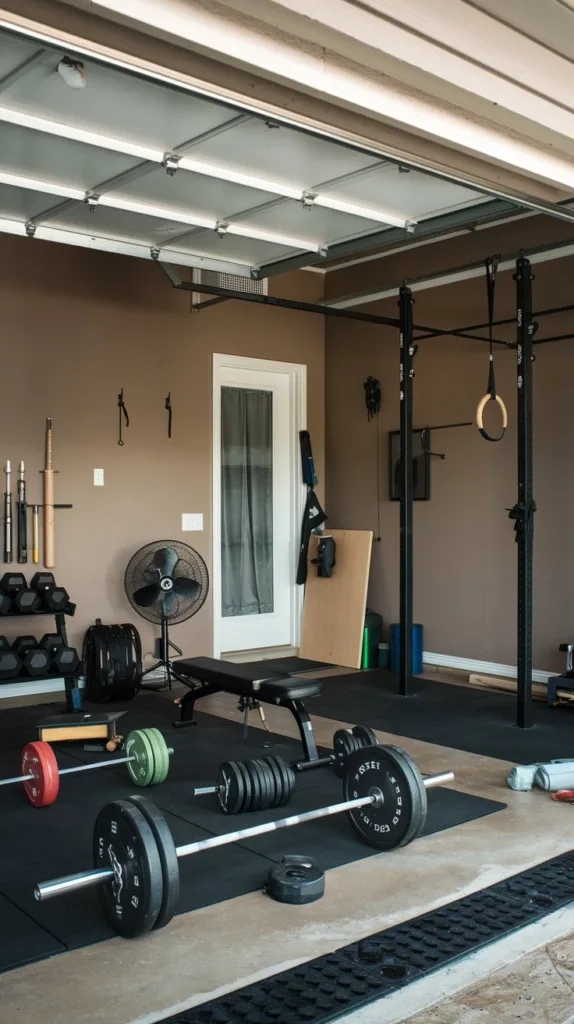
A well-designed Garage Gym Setup requires more than just equipment—it needs air that supports peak performance. Proper ventilation prevents stale air buildup during intense workouts, safeguarding both health and equipment longevity. Natural airflow starts with strategic window placement and door alignment to create cross-ventilation. Positioning vents opposite workout zones circulates air efficiently, even in smaller spaces.
Mechanical solutions like ceiling fans or exhaust systems address spaces lacking natural airflow. For example, Lincoln Street fans by MacroAir, with diameters up to 84 inches, enhance air movement in large Custom Garage Gym layouts. HVAC systems should meet minimum OSHA standards of 20 cfm per person, while ASHRAE recommends 30 cfm in high-usage areas. Filters with MERV ratings 8-13 trap dust and allergens, maintaining clean air during resistance training or cardio sessions.
Humidity control is vital in garages with concrete floors. Dehumidifiers paired with air quality sensors automatically adjust moisture levels, preventing rust on weights and mold on rubber flooring. Smart technology, favored by 86% of homeowners, allows programmable settings via apps to regulate temperature and airflow during HIIT or yoga routines. Regular filter changes and duct cleaning ensure systems operate at peak efficiency, extending equipment life and improving workout comfort.
Personalizing Your Workout Space
Transforming your garage into a dedicated workout area begins with Home Gym Ideas tailored to your fitness objectives. Whether your focus is on intense training or yoga, your Garage Gym Design should mirror your specific regimen. Start by dividing the space into distinct zones for strength, cardio, and recovery. This approach, even in compact areas, optimizes your workout layout. Incorporate adjustable benches and wall-mounted racks to enhance efficiency. Strategic lighting further improves focus during your sessions.
Integrating technology elevates the workout experience. Smart mirrors, Bluetooth-enabled gear, and wall-mounted TVs can transform any space. Today, over 86% of homeowners value tech, such as workout tracking systems, for making sessions more engaging. Brands like Life Fitness provide connected treadmills and rowers that link with fitness apps, allowing real-time progress tracking.
Branding your workout area fosters a deeper commitment. Select a name, color scheme, or motivational quotes to reinforce your daily routine. Polyaspartic flooring, renowned for its durability, supports the weight of heavy equipment while ensuring safety. By combining these elements, your garage becomes a customized environment that promotes regular exercise. Research indicates that personalized setups can increase workout frequency by up to 45%. This demonstrates that a well-thought-out design is key to achieving long-term fitness goals.
Maintenance Tips for Your Garage Gym
Maintenance is key to keeping your Garage Gym Setup running smoothly for years. Simple actions like wiping down equipment after each use can prevent rust and corrosion. Sweat, rich in sodium chloride, can damage metal. Regularly brushing your barbell and applying 3-in-1 oil protects handles and knurling.
Vacuuming your floors daily is essential to remove debris that can wear down your equipment. Rubber gym mats not only protect against drops and moisture but also act as insulation against seasonal changes.
Seasonal checks are critical. In winter, condensation and summer humidity require the use of dehumidifiers to maintain dry air. Every three months, inspect your equipment for loose bolts or frayed cables. Treadmills need servicing every 90 days to ensure safety.
Even a $58 monthly gym fee adds up to $6,960 over ten years. Proper care can prevent the need for expensive replacements, making your Budget Home Gym a worthwhile investment. Consider repurposing wooden crates for storage and using foldable racks to save space.
Consistency is the key to turning small habits into lasting benefits. Create a monthly maintenance calendar to track tasks such as checking insulation gaps or applying lubricants. A clean Garage Gym Setup helps avoid mold growth, common in commercial gyms. With the right care, even a $10,000 setup can last decades.
Remember to dry equipment after each workout and store tools in weather-resistant containers. Update your space as the seasons change. These steps will ensure your investment remains strong, allowing you to focus on your fitness journey without worrying about costly repairs.

